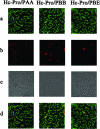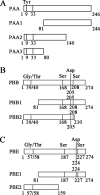HC-Pro protein of Potato virus Y can interact with three Arabidopsis 20S proteasome subunits in planta
- PMID: 17898064
- PMCID: PMC2169110
- DOI: 10.1128/JVI.00913-07
HC-Pro protein of Potato virus Y can interact with three Arabidopsis 20S proteasome subunits in planta
Abstract
The multifunctional protein helper component proteinase (HC-Pro) is thought to interfere with the activity of the 20S proteasome; however, no sites of interaction have been identified for either protein. Here, we first show that the Potato virus Y (PVY) HC-Pro protein can interact with three Arabidopsis 20S proteasome subunits (PAA, PBB, and PBE), using a yeast two-hybrid system and the bimolecular fluorescence complement assay. In addition, yeast two-hybrid analysis of the interaction between several mutant subunits of the 20S proteasome and PVY HC-Pro confirmed that residues 81 to 140 of PAA, 1 to 80 of PBB, and 160 to 274 of PBE are necessary for binding PAA, PBB, and PBE to PVY HC-Pro, respectively. Deletion mutant analysis of PVY HC-Pro showed that the N terminus (residues 1 to 97) is necessary for its interaction with three Arabidopsis 20S proteasome subunits. The ability of HC-Pro to interact and interfere with the activity of the 20S proteasome may help explain the molecular basis of its multifunctional character.
Figures







Similar articles
-
The HC-pro protein of potato virus Y interacts with NtMinD of tobacco.Mol Plant Microbe Interact. 2007 Dec;20(12):1505-11. doi: 10.1094/MPMI-20-12-1505. Mol Plant Microbe Interact. 2007. PMID: 17990958
-
Helper component-proteinase enhances the activity of 1-deoxy-D-xylulose-5-phosphate synthase and promotes the biosynthesis of plastidic isoprenoids in Potato virus Y-infected tobacco.Plant Cell Environ. 2015 Oct;38(10):2023-34. doi: 10.1111/pce.12526. Epub 2015 Apr 27. Plant Cell Environ. 2015. PMID: 25736930
-
The 20S proteasome α5 subunit of Arabidopsis thaliana carries an RNase activity and interacts in planta with the lettuce mosaic potyvirus HcPro protein.Mol Plant Pathol. 2011 Feb;12(2):137-50. doi: 10.1111/j.1364-3703.2010.00654.x. Epub 2010 Sep 24. Mol Plant Pathol. 2011. PMID: 21199564 Free PMC article.
-
Potyviral HC-Pro: a multifunctional protein.J Gen Virol. 1996 Jul;77 ( Pt 7):1335-41. doi: 10.1099/0022-1317-77-7-1335. J Gen Virol. 1996. PMID: 8757972 Review. No abstract available.
-
Potyviral Helper-Component Protease: Multifaced Functions and Interactions with Host Proteins.Plants (Basel). 2024 Apr 29;13(9):1236. doi: 10.3390/plants13091236. Plants (Basel). 2024. PMID: 38732454 Free PMC article. Review.
Cited by
-
Intracellular coordination of potyviral RNA functions in infection.Front Plant Sci. 2014 Mar 26;5:110. doi: 10.3389/fpls.2014.00110. eCollection 2014. Front Plant Sci. 2014. PMID: 24723931 Free PMC article. Review.
-
Ubiquitin-Like protein 5 interacts with the silencing suppressor p3 of rice stripe virus and mediates its degradation through the 26S proteasome pathway.PLoS Pathog. 2020 Aug 31;16(8):e1008780. doi: 10.1371/journal.ppat.1008780. eCollection 2020 Aug. PLoS Pathog. 2020. PMID: 32866188 Free PMC article.
-
HC-Pro silencing suppressor significantly alters the gene expression profile in tobacco leaves and flowers.BMC Plant Biol. 2011 Apr 20;11:68. doi: 10.1186/1471-2229-11-68. BMC Plant Biol. 2011. PMID: 21507209 Free PMC article.
-
The Ubiquitin Proteasome System as a Double Agent in Plant-Virus Interactions.Plants (Basel). 2021 May 6;10(5):928. doi: 10.3390/plants10050928. Plants (Basel). 2021. PMID: 34066628 Free PMC article. Review.
-
Potato virus Y HC-Pro Reduces the ATPase Activity of NtMinD, Which Results in Enlarged Chloroplasts in HC-Pro Transgenic Tobacco.PLoS One. 2015 Aug 26;10(8):e0136210. doi: 10.1371/journal.pone.0136210. eCollection 2015. PLoS One. 2015. PMID: 26309250 Free PMC article.
References
-
- Apcher, G. S., S. Heink, D. Zantopf, P. M. Kloetzel, H. P. Schmid, R. J. Mayer, and E. Kruger. 2003. Human immunodeficiency virus-1 Tat protein interacts with distinct proteasomal alpha and beta subunits. FEBS Lett. 553:200-204. - PubMed
-
- Aviel, S., G. Winberg, M. Massucci, and A. Ciechanover. 2000. Degradation of the Epstein-Barr virus latent membrane protein 1 (LMP1) by the ubiquitin-proteasome pathway. Targeting via ubiquitination of the N-terminal residue. J. Biol. Chem. 275:23491-23499. - PubMed
-
- Ballut, L., M. Drucker, M. Pugniere, F. Cambon, S. Blanc, F. Roquet, T. Candresse, H. P. Schmid, P. Nicolas, O. L. Gall, and S. Badaoui. 2005. HcPro, a multifunctional protein encoded by a plant RNA virus, targets the 20S proteasome and affects its enzymic activities. J. Gen. Virol. 86:2595-2603. - PubMed
-
- Ballut, L., F. Petit, S. Mouzeyar, O. Le Gall, T. Candresse, P. Schmid, P. Nicolas, and S. Badaoui. 2003. Biochemical identification of proteasome-associated endonuclease activity in sunflower. Biochim. Biophys. Acta 1645:30-39. - PubMed
Publication types
MeSH terms
Substances
LinkOut - more resources
Full Text Sources

